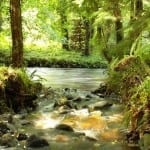
Forests and Water
Water is the most vital element of all natural resources and is essential to life. Forests and woodlands have a close relationship with our water resources, and forest management and water quality are closely linked.
It is widely recognised that sustainably managed forests play an important role in maintaining water quality. Through stabilisation of soil, forests minimise erosion and hence reduce the impairment of water quality due to sedimentation. Woodlands protect water bodies and watercourses by trapping sediments and pollutants from other up-slope land use and activities. In Europe, 96.3 million hectares of forests are designated for the protection of soil and water. This corresponds to 10 percent of the total forest area.
Forests also play a role in water availability. They influence the amount of available water by intercepting precipitation, evaporating moisture from vegetative surfaces, transpiring soil moisture, capturing fog water and maintaining soil infiltration. At the same time, forests may influence the timing of water delivery by maintaining and improving soil infiltration and the soil’s water-storage capacity.
In Ireland many private and public water schemes have their origins in forested areas as these are preferred sources of drinking water for human consumption. Forestry as a land use has very low inputs of nutrients and chemicals. When applied, fertilisers and approved pesticides are sparingly used, maybe two or three times during the life of a crop (40 to 120 years depending on the species). Compared with other land uses, where annual or often multi-annual applications are made, this usage is extremely low.


